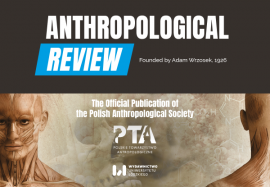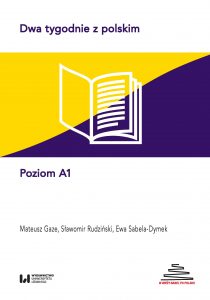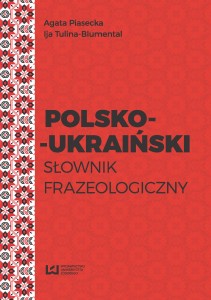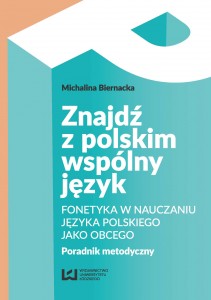Anthropological Review | Vol. 86 No. 4 (2023)
Opublikowano: 3 stycznia 2024

Anthropological Review (dawniej Przegląd Antropologiczny i Przegląd Antropologiczny – Anthropological Review) to oficjalna publikacja Polskiego Towarzystwa Antropologicznego wydawana przez Wydawnictwo Uniwersytetu Łódzkiego. Czasopismo ma długą tradycję publikowania od momentu założenia w 1926 roku przez wybitnego polskiego antropologa fizycznego i lekarza Adama Wrzosa. Czasopismo ukazuje się kwartalnie przy wsparciu finansowym Ministerstwa Nauki i Szkolnictwa Wyższego RP. Od 1997 roku, Anthropological Review publikuje w języku angielskim i jest czasopismem naukowym poświęconym zagadnieniom antropologii fizycznej (m.in. zmienność biologiczna człowieka, wzrost i rozwój człowieka, paleoantropologia, biologia szkieletu, antropologia stomatologiczna) oraz dziedzinom pokrewnym (m.in. psychologia, biologia teoretyczna, demografia). Czasopismo stara się zatem promować interdyscyplinarne spojrzenie na człowieka.
Punktacja MEiN: 140 punktów (lipiec 2023)
Artykuły dostępne w j. angielskim.
W numerze (PDF):
Spina bifida oculta in skeletal population from Dąbrówki (Poland, Podlaskie Province)
Anna Myszka, Adrian Wolski, Joanna Wawrzeniuk, Jacek Tomczyk
The aim of the study is to evaluate the frequency of spina bifida oculta (SBO) in the early modern population from Dąbrówki (Poland); 26 males, 19 females, 3 adults with unspecified sex, 2 subadult were taken into the analysis. SBO was found in 9 individuals (18%), of whom only one exhibited a complete cleft in the sacrum (2%). In males, SBO was reported in 7 out of 26 skeletons studied (27%). Complete cleft was observed in one individual (4%), partial cleft in 6 individuals (23%). In females, no case of complete cleft was detected (0%), and one case of partial cleft was found (5%). These differences between males and females in the frequency of this skeletal condition were statistically significant.
Due to the lack of uniform methods for SBO analyses, the inability to make interpopulation compari-sons, the relatively high prevalence of the SBO phenomenon in ancient and modern populations, and the unclear etiology of the disease, research on SBO should be continued.
Dyslipidemia in pre- and post-menopausal women: a study of peri-urban Paundra Kshatriya women
Dipak Kumar Adak, Nitamoni Bharali, Saptarshi Biswas, Niloy Kumar Bagchi, Tapas Kumar Biswas, Vadlamudi Raghavendra Rao
Dyslipidemia is an important risk factor of cardiovascular disease, whereas menopause is a decrease in ovarian follicular activity at the end of reproductive age of the women, which is significantly influenced by hormonal changes brought on by menopause’s impact on serum lipids. This study was undertaken among pre- and post-menopausal Paundra Kshatriya women in Sonarpur, South 24 Parganas, West Bengal, India in order to determine the prevalence of dyslipidemia. 142 adult Paundra Kshatriya women (n pre-menopausal women = 96; n post-menopausal women = 46) were selected from a peri-urban setting of Sonarpur, South 24 Parganas, West Bengal. Anthropometry and arterial pressure data were recorded. Blood samples were collected from study participants who were on 12 hours fasting. 19.79% of pre-menopausal women and 17.39% of post-menopausal women had normal levels of lipids. Prevalence of dyslipidemia was slightly higher (82.7%) among the post-menopausal women compared to pre-menopausal women (80.2%). While high LDL cholesterol emerged as one of the prime causes for dyslipidemia among pre-menopausal women, hypercholesterolemia emerged as one of the prime causes for dyslipidemia among post-menopausal women. Regression analysis revealed a significant impact of 3 factors in pre-menopausal women and impact of 6 factors in post-menopausal women. Though Paundra Kshatriya women maintain a relatively less stressful and high physical activity lifestyle, they exhibited high levels of lipid abnormalities. The peri-urban population is undergoing lifestyle and dietary changes due to a close proximity to the urban centre, Kolkata.
The diet of the human groups buried in a late- and post-Medieval rural parish cemetery in Libkovice (Czech Republic)
Aleksandra Karykowska, Paweł Konczewski, Barbara Kwiatkowska, Joanna Witan, Aleksandra Lisowska-Gaczorek, Krzysztof Szostek
Libkovice is a village in the northwestern Czech Republic that was demolished at the end of the last century due to the expansion of a nearby mine. The former church cemetery has been a subject to bioarchaeological excavation and research, where some 850 burials from the 13th to the 19th Century have been discovered so far. With the application of stable isotope analysis, it has also been possible to uncover the dietary patterns of this exemplary rural Central European community, which was the aim of this study.
The materials analysed here consist of samples from long bones of 56 burials and 18 animal bones discovered in Libkovice during the 2019/21 excavations. It has been employed stable carbon (δ13C) isotope analysis to determine the average contributions of foods derived from the C3 plants.
Statistically significant differences were found between the analyzed fauna and human samples for nitrogen (F=47.4 p<0.05) and carbon (F=19.18 p<0.05). There were no statistically significant differences in the analyzed animal and human samples between the specify centuries. When considering the ages of various human individuals, the results indicated statistically significant differences in nitrogen isotopes (F= 7.71 p<0.05) between children from the infants I group and older children together with adults from the Middle Ages, as well as between children from the infants I group and adults (F= 3.3, p<0.05) from the modern times. The proportion of food from C3 plants that made up the diets of the studied population was on average 89%, and the potential proportion of freshwater fish in the diet could be higher than 80%.
The similarity between the chronologically diverse groups may indicate similar strategies for food acquisition. The results obtained for the population of Libkovice are very similar to the diets of the populations living in Central Europe broadly during the two periods.
Relationship between body sway and body build in healthy adult men and women
Anna Lipowicz, Monika N. Bugdol, Katarzyna Graja, Katarzyna Nowakowska-Lipiec, Katarzyna Jochymczyk-Woźniak, Dobrochna Fryc, Robert Michnik, Andrzej W. Mitas
Studies investigating the relationship between balance ability and body size, build and proportions tend to concentrate on body mass and height rather than breadth parameters or size of individual body segments. The purpose of this study was to determine a relationship between the ability to keep balance and the size, build and proportions, based on breadth and length dimensions of the body in healthy adult men and women during a position of free standing. This study also aimed to investigate how the lack of visual control affects the analyzed relationship. The study group consisted of 102 adults of both sexes. The investigations encompassed anthropometric measurements of the body and the ability to keep balance. The analysis covered a of series anthropometric parameters, 9 indices of body proportions, mean velocity of the COP movement (MV) and ellipse area (EA). A statistical analysis of the results was carried out taking into consideration the division into groups due to sexes. The results of the Pearson correlation have revealed that there is a statistically significant correlation (weak or moderate degree) between anthropometric parameters of the body and stabilographic values. Results differ between sexes and depend on whether Romberg’s test was performed with open or closed eyes. The obtained results showed that the surface area of ellipse significantly depends on the dimensions of these body elements which relate to the position of the centre of mass. The obtained results, which differ depending on sex, show that the values of the body sways in a position of free standing depend on breadth and length dimensions of the body, visual control and the analyzed parameter of balance.
Morphological and genetic aspects of Marfan Syndrome as demonstrated by a case of death during pregnancy with the discovery of two de novo missense mutations in the FBN1 gene
Isabella Aquila, Matteo Antonio Sacco, Silvia Boca, Donatella Malanga, Giuseppe Viglietto, Ludovico Abenavoli, Martino Maesani, Elena Varotto, Francesco Maria Galassi, Pietrantonio Ricci
Marfan Syndrome (MFS) is an autosomal dominant disease caused in most cases by mutations in the FNB1 gene, which encodes for fibrillin 1. MFS does not alway shows typical phenotypic signs. Indeed, the occurrence of sudden death of unknown cause is increasingly seen in young adults without ante mortem preexisting pathology to explain the event. In many cases the diagnosis of Marfan Syndrome (MFS) is carried out post mortem, especially in cases where the disease’s external phenotype is absent. Here is reported a case of a young woman who died during a twin pregnancy investigated with medico-legal and forensic anthropological procedures. The autopsy showed the absence of a typical marfanoid habitus and the presence of a dissecting aneurysm of the aorta with histopathological degeneration of the aortic elastic fibers. The genetic investigation revealed two previously undetected de novo mutations of the FBN1 gene: c.T6181C: p.C2061R and c.G1415A: p.C472Y. This new mutations, together with a comprehensive analysis, demonstrates the existence of a causal relationship between these mutations and the dissecting aneurysm of the aorta. This also stresses the importance of a combined multidisciplinary approach to this condition which includes morphological and genetic studies.
Reliability of retrospective assessment of the age of first menstruation
Ryszard Żarów, Agnieszka Woronkowicz, Barbara Spring, Małgorzata Kowal, Janusz Brudecki
The age of the first menstruation is one of the indicators for assessing the course of puberty. It is also a sensitive indicator of the economic situation of individual professional groups or societies, and the low average age of menarche is widely recognized as a marker of society’s well-being. The aim of the study was to analyse the reliability of the retrospective method of assessing the age at menarche by comparing the results to the age obtained from continuous research. Data regarding the age at menarche came from longitudinal somatic development and physical fitness studies conducted between 1976 and 2022. In 2022, 47 women were examined. In continuous studies, the prospective method was used in the assessment of the age of first menstruation while in the 2004 and 2022 studies a retrospective method was applied. Only in 4 out of 47 women the age of the first menstruation declared in 2004 and 2022 (the women were 32–34 and 50–52 years old, respectively) was consistent with the one found in continuous studies. In other cases, there was a discrepancy between the age found in continuous studies and self-reported in 2004 or 2022 or between the age stated in 2004 and 2022. Of those women who were present for the 2022 study, 36 had information about the age of first menstruation from continuous studies and the age of menarche in 2004 was given. For this sample the arithmetic mean and the standard deviation of the age at menarche were calculated. It was found that the retrospective method often used in the assessment of the age of the first menstruation is not fully reliable, as the average discrepancy in the assessment ranged from nearly 1 month (0.05 years) to over 2 months (0.19 years) compared to the prospective method. Women surveyed in 2004 determined the age of the first menstruation more accurately compared to statements obtained 18 years later from the same women. This study suggests that long-term memory (LTM) of a significant life event of every woman is unreliable, as indicated by the difference in the declared age of the first menstruation of women examined in 2004 and 2022, which, in individual cases, was up to 3, 4 or 5 years.
Cardiometabolic risk assessment in Eastern Slovak young adults using anthropometric indicators
Michaela Zigová, Eva Petrejčíková, Marta Mydlárová Blaščáková, Jana Gaľová, Hedviga Vašková, Soňa Kalafutová, Miriama Šlebodová
Introduction: Selected anthropometric indicators, such as anthropometric measurements, indices, or ratios could be reliable predictors of future cardiometabolic risk in primary prevention, especially in young adults.
Aim: This study aimed to establish cardiometabolic risk status in young Eastern Slovak adults according to anthropometric indicators.
Material and methods: Indicators used in this study, such as heart rate, blood pressure, five anthropometric measurements, as well as a total of 23 anthropometric indices and ratios were selected based on the available literature. These indicators were analyzed in 162 young adult participants of both sexes with a mean age of 20.78±2.22 years. The analyzed indices and ratios were calculated by routine anthropometry and were correlated with blood pressure and heart rate in the whole research group as well as among subgroups divided according to sex, obesity and hypertension status.
Results: Our results showed frequently higher values of input characteristics in males (71.88%), and statistically significant differences between sexes in 81.25% of the characteristics. The values of systolic blood pressure were above the norm in all males, and they also dominated in the obesity group. Correlation analyses conducted on all participants and in subgroups indicated a positive statistical significance in several indicators. The vast majority of the anthropometric indicators were significantly correlated with physiological indicators in almost all subgroups. Only A body shape index(ABSI) correlation coefficients did not show a significant correlation with physiological indicators in all analyzed subgroups. The correlations tended to be stronger among subgroup exhibiting potential to obesity. All analyzed indices and ratios were significantly correlated (p ≤ 0.05), predominantly with blood pressure components rather than heart rate, especially in participants with the potential for disease complications than in participants without them.
Conclusion: The analyzed indicators are noninvasive and useful although they may be at different levels of association and clinical significance for various conditions. Thus some of the indicators may be standardly used in the early diagnostic process for monitoring cardiovascular health and risk stratification of patients.
The age difference in 2D:4D among the Polish population: An exploratory study
Paulina Pruszkowska-Przybylska, Magdalena Kobus, Elżbieta Żądzińska, Iwona Rosset, Milena Pruszkowska, Wojciech Kuczyński, Aneta Sitek
In this study a widely debated association between 2D:4D digit ratio and age was investigated. The study material included 960 individuals (530 females and 430 males) from Central Poland aged between 6–79 years. The information about age was obtained via survey filled in by study participants or, if underaged, their parents. The direct measurements of the second and fourth finger were performed to assess the 2D:4D digit ratio. The 2D:4D digit ratios for the left hand were significantly correlated with age both among females and males. In women the 2D:4D digit ratios for the right hand were significantly correlated with age. There were also significant differences in digit ratio between age groups. The results of our study suggest that there might be an association between digit ratio and age, and the direction of the correlation might be related to the phase of the ontogenesis.
Komentarze
Ten post dostępny jest także w języku: angielski





